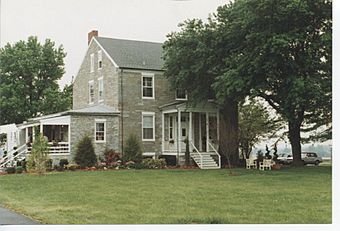Carrollton Manor facts for kids
Quick facts for kids |
|
|
Carrollton Manor
|
|

Manor House on Manor Woods Road
|
|
| Location | 5809 Manor Woods Rd., Buckeystown, Maryland |
|---|---|
| Area | 32 acres (13 ha) |
| Built | 1820 |
| Architectural style | Greek Revival, Federal, Early Republic |
| NRHP reference No. | 97001294 |
| Added to NRHP | November 17, 1997 |
Carrollton Manor was a huge piece of land in Frederick County, Maryland, USA. It covered about 17,000 acres (69 square kilometers). This large estate stretched from the Potomac River in the south to Catoctin Mountain in the west. It also reached the Monocacy River in the east and Ballenger Creek in the north. Many towns were part of this manor, including Lime Kiln, Buckeystown, Adamstown, Doubs, Licksville, Tuscarora, and Point of Rocks.
Contents
The Carroll Family and Their Land
Carrollton Manor was originally owned by Charles Carroll of Annapolis. He gave this entire estate to his son, Charles Carroll of Carrollton. The younger Charles Carroll took his famous name, "Charles Carroll of Carrollton," from this very land.
The Manor House: Tuscarora
Even though Charles Carroll of Carrollton never lived full-time at Carrollton Manor, he built a special manor house there called Tuscarora. He would visit for a few days or weeks at a time. This house later became home to his favorite granddaughter, Marianne Caton, and her husband, Robert Patterson.
The house is a two-story building made of local limestone. It was built around 1820 and shows the Federal architecture style. When it was first built, it had 14 rooms. Later, more rooms were added, bringing the total to 21. The walls are very thick, about twenty-four inches. The floors are made of oak, and many doors still have their original latches. Most of the inner partitions are solid brick.
When you enter through the wide front door, you find a rectangular reception hall. From here, you can go into the other rooms. There are two drawing rooms and a grand stairway that goes from the basement all the way to the attic. Each room in the house has its own fireplace. Tuscarora was added to the National Register of Historic Places in 1997.
Important Daughters and Their Marriages
Charles Carroll of Carrollton's oldest daughter married Richard Caton. They had three daughters who became known as the "three American graces." These women married important British noble men.
- The oldest daughter, Marianne, married the Marquess Wellesley. He was the brother of the famous 1st Duke of Wellington.
- The second daughter, Louisa Catherine, first married Sir Felton Hervey-Bathurst. Later, she married the 7th Duke of Leeds.
- The third daughter, Elizabeth, married the 8th Lord Stafford.
These noble ladies kept parts of the manor for many years. They collected a lot of money from renting out the many rich farms on the estate.
Industry and Farming on the Manor
In the early 1800s, Carrollton Manor was a busy place for industry. Mills were built on the Monocacy River to grind grain using water power. Charles Carroll changed the farm's focus from tobacco to wheat.
Kilns were also set up to burn lime. This lime was used to fertilize the fields, helping crops grow better.
Changes and New Owners
The Pattersons, Marianne and Robert, lived at Tuscarora for only a few years. When an illness spread in the area, they moved to Baltimore. Sadly, Mr. Patterson passed away a few days later. After his death, tenants lived in Tuscarora.
Over time, Carrollton Manor became smaller. It was divided into many small farms. Eventually, only about two thousand acres (8 square kilometers) remained.
Selling Off the Estate
After Charles Carroll of Carrollton died, the estate went to his descendants. Since his heirs lived all over the world, they hired people to manage their interests. Soon, most of Carrollton Manor was sold or leased.
One of the big buyers was Louis McMurray. He was the first person to start the corn canning industry in Frederick County. He also canned peas and other vegetables. Two large canning plants were built on Carrollton Manor. One was in Buckeystown, Maryland, run by the Baker Brothers. The other was in Adamstown, run by the Thomas Brothers.
Tuscarora's Decline and Revival
Careless tenants did not take good care of Tuscarora. At one point, turkeys were raised in a bedroom, hogs lived in the basement, and cured hams hung from the attic. The Carroll family descendants owned Carrollton Manor as absentee landlords until around 1923. Then, the Baker family bought it.
Around 1949, two of the original farms of the Manor were sold to Mr. and Mrs. Pascal Renn. They made many improvements to Tuscarora. They filled it with antiques and copies of furniture from the colonial period. In 1953, the house was opened for a Garden Pilgrimage. Surprisingly, the banisters and stairway were still in good condition. The woodwork was fine, and the cupboards, inner window shutters, and doors were still in place.
In the 1950s, the Renns sold the farm to Eastalco. This company built a large aluminum plant on the farm. Tuscarora is still standing today. It is used by Eastalco's current owner, Alcoa, as a guest house and meeting center.
Other Carrollton Manor Communities
There is also a Carrollton Manor community in Anne Arundel County, Maryland.
Images for kids
- Carrollton Manor, including 2006 photo, at Maryland Historical Trust




